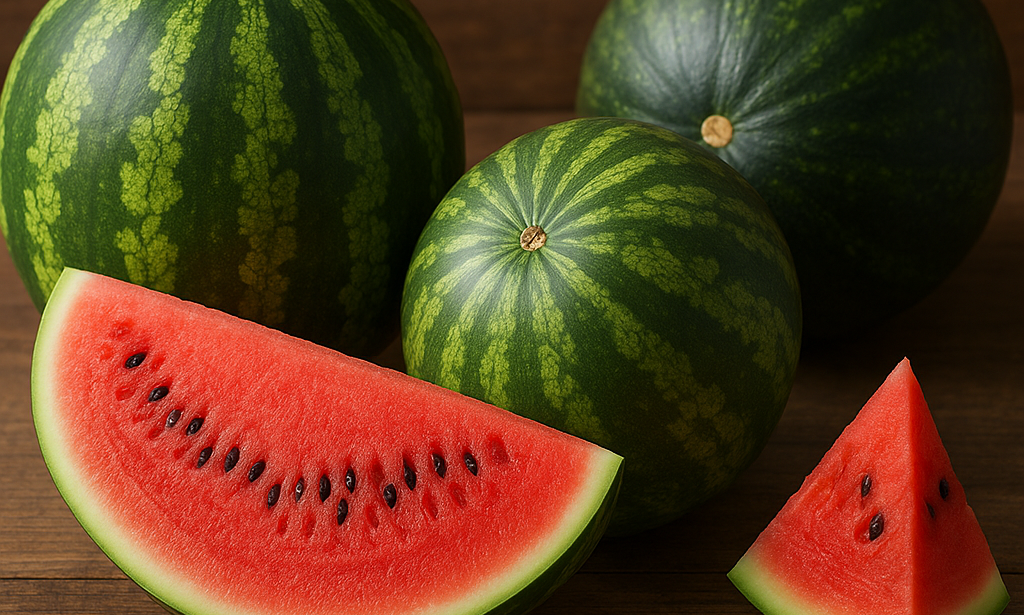
How to Plant Watermelon in Your Garden: A Detailed Guide
Growing watermelon in your garden is not only a satisfying hobby but also a deliciously rewarding one. With the right conditions and proper care, you can harvest sweet, juicy melons right from your backyard. This guide walks you through the entire process—from preparing the soil to harvesting your fruits.
Quick Highlights
-
Ideal soil: Loamy, sandy, and well-drained with a pH between 6.0 and 7.5.
-
Climate: Thrives in warm weather (20–30°C) and requires 600–1,200 mm of annual rainfall.
-
Seed selection: Choose high-yielding hybrid varieties like Sweet Rose F1, Crimson Sweet, or Sugar Baby.
-
Best planting time: February or March for optimal growth and market value.
-
Fertilization: Use cow manure, DAP, and Polysulphate for healthy growth.
-
Watering: Consistent moisture is key—about 1 inch per week.
1. Preparing the Soil
Watermelons grow best in loamy or sandy soils that drain well. Avoid heavy clay soils unless you improve them with organic matter. Test your soil's pH—it should range from 6.0 to 7.5. Amend the soil as needed before planting.
2. Understanding Climate Requirements
Watermelons flourish in sunny locations with temperatures between 20–30°C and do best at altitudes below 1,500 meters. If rainfall is inconsistent, use irrigation to keep the soil evenly moist. Consistent watering is essential to prevent cracking and promote even fruit development.
3. Choosing the Right Seeds
For the best yield, opt for hybrid seeds known for high quality and productivity. Popular options include:
-
Sweet Rose F1
-
Crimson Sweet
-
Sugar Baby
-
Kubwa F1
-
Zuri F1
-
Sukari F1
These seeds are available at certified agro-dealer outlets.
4. Step-by-Step Planting Guide for Beginners
-
Choose a sunny spot with good air circulation and soil drainage.
-
Space rows 3 to 6 feet apart, and leave 3 to 4 feet between plants.
-
Dig planting holes twice the size of the root ball.
-
Mix in well-rotted compost or cow manure into each hole.
-
Place the seedling or seed in the hole and cover gently with soil.
-
Water deeply to help roots establish.
-
Maintain consistent moisture, especially during flowering and fruiting.
-
Use a trellis or straw mulch to keep fruits off the ground and prevent rotting.
5. Ideal Planting Time
For the best results, plant your watermelon in February or March. These months offer favorable weather conditions and less market saturation—especially important if you're growing for profit.
6. Watermelon Growth Timeline
Watermelons take about 90 to 120 days to mature. Here’s how to know when they're ready:
-
Check the underside of the fruit for a creamy yellow spot.
-
Inspect the curled tendril nearest the fruit—when it dries up and turns brown, your melon is ripe.
After harvesting, watermelons can be stored for:
-
7–10 days at room temperature
-
Up to 2 weeks when refrigerated
FAQs: Common Watermelon Growing Issues
Q: How can I make my watermelon grow faster?
A: Use drip irrigation, plant on mounds, and apply balanced fertilizers.
Q: Why have my melons stopped growing?
A: Poor drainage or clay-heavy soil is likely to blame.
Q: What fertilizers boost fruit size?
A: Polysulphate enhances size and sweetness.
Q: Is cow manure effective?
A: Yes, especially when combined with inorganic fertilizers like DAP.
Q: Why do melons crack?
A: Uneven watering causes internal pressure that leads to cracking.
Final Thoughts
By selecting the right location, maintaining good soil health, choosing quality seeds, and watering consistently, anyone—from backyard gardeners to commercial farmers—can grow sweet, delicious watermelons. With a little patience and care, your garden can produce an abundant harvest all season long.


You must be logged in to post a comment.